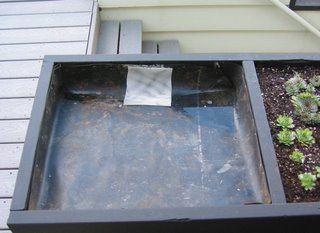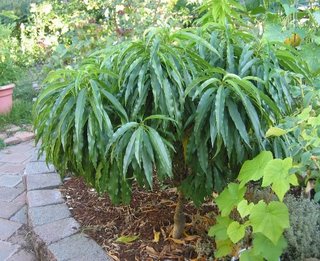
This view shows an individual compartment, lined with recycled pond liner. The white area is a plastic mesh cover, made from a used mesh bag (that originally contained garden bulbs). The mesh covers the pipe outlet. The bottom of the box slopes about 1 inch per foot, toward the drain. The pipe is the only item specifically purchased so far for this project, 3/4" inside diameter rubber tube (about $1.75 for the entire length).

Close up of drain arrangement. The white plastic mesh was stapled to the side of the box so that it would not move around. The plastic pond liner is stretched around the end of the pipe.

After adding growth medium. The growth medium is "Whitney's organic potting soil", lightened with about 25% perlite for better drainage. After exploring the plant options,
sedum was used in addition to
sempervivum. About 1/2 of the plants were scrounged from around the yard, mainly S
empervivums that have multiplied and spread in several locations, and needed thinning, and
Sedums that have been used for ground cover in dry locations. The other 1/2 were from end-of-summer sale at Portland Nursery. This view is from the stairway. Coming up the stairs, the plants can be viewed at eye-level.

Viewed from front door. My only real concern is that this is on the North side of the house, and the succulents may not flourish there. I think they will do OK, since there are already some at ground level on the North side of the house and North of a large tree.
This project is inspired by various green roof articles, such as a university site from
Michigan, a
do-it-yourself garage roof (with nice photos), a do-it-yourself roof in
Vancouver Canada, and some sites in the
UK. Even though it is the top of a small wall, it actually does serve as a small roof for a basement room, and the existing wall did leak into the basement. I'm hoping that with the pond liner and the drain system, the leakage will no longer occur, and that the plants will not require summer watering or other significant care.
















